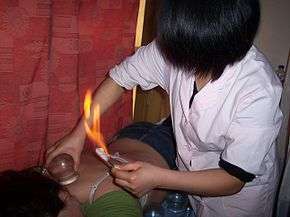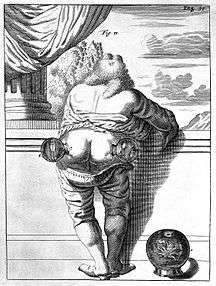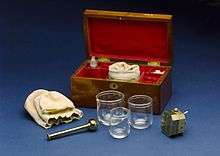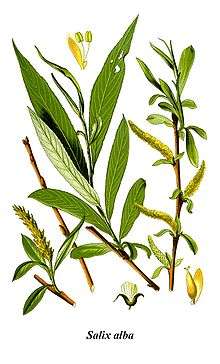Cupping therapy

Cupping therapy is a form of alternative medicine in which a local suction is created on the skin. Cupping has been characterized as pseudoscience.[1] There is no good evidence it has any benefit on health and there are some concerns it may be harmful.[2]
Description
Through suction, the skin is drawn into the cup by creating a vacuum in the cup placed on the skin over the targeted area. The vacuum can be created either by the heating and subsequent cooling of the air in the cup, or via a mechanical pump.[3] The cup is usually left in place for somewhere between five and fifteen minutes. It is believed by some to help treat pain, deep scar tissues in the muscles and connective tissue, muscle knots, and swelling; however, the efficacy of this is unproven.[2]
Effectiveness
Cupping as of 2015 is poorly supported by evidence.[4] In their 2008 book Trick or Treatment, Simon Singh and Edzard Ernst write that no evidence exists of any beneficial effects of cupping for any medical condition.[5] A 2011 review found tentative evidence for pain but nothing else.[6] The way it works is unclear but might involve the placebo effect.[7] A 2015 review found it was useful, at least temporarily, for long term neck and low back pain.[7]
The effectiveness of cupping is difficult to determine as it is difficult to construct a double blind or placebo-controlled clinical trial.
Some claim cupping is an alternative treatment for cancer. However, the American Cancer Society notes that "available scientific evidence does not support claims that cupping has any health benefits" and also that the treatment carries a small risk of burns.[2]
Side effects
Cupping is generally safe when done by trained health professionals on people who are otherwise healthy.[7] It is not recommended in people with health problems due to side effects.[7] Cupping is not recommended as a replacement for typical treatment.[7] Cupping may result in bruising, burns, pain, or skin infection.[7]
Research suggests that cupping is harmful, especially in people who are thin or obese. According to Jack Raso (1997), cupping results in capillary expansion, excessive fluid accumulation in tissues, and the rupture of blood vessels.[8]
Fire Cupping can sometimes result in minor to severe burns, and can lead to hospitalization and may even require skin grafting to repair the injury. Also other burns due to carelessness with the flammable substances being used, such as spills and over application can also occur.[9][10]
Reception
Individuals have been performing the action for over 3,000 years. The practice is typically performed unsupervised, without any medical background. Traditional Persian medicine in Iran uses wet cupping practices, with the belief that cupping with scarification may eliminate the scar tissue, and cupping without scarification would cleanse the body through the organs.[11] Individuals with a profound interest in the practice are religious and seek purification.
Cupping has gained publicity due to its use by American sport celebrities including National Football League player DeMarcus Ware and Olympians Alexander Naddour, Natalie Coughlin, and Michael Phelps.[12] Medical doctor Brad McKay wrote that Team USA was doing a great disservice to their fans who might "follow their lead", calling cupping an "ancient (but useless) traditional therapy."[13] Practicing surgeon David Gorski claims, "it’s all risk for no benefit. It has no place in modern medicine".[14]
Critics of alternative medicine such as Harriet Hall, Mark Crislip, Simon Singh and Edzard Ernst call cupping "pseudoscience nonsense", "a celebrity fad", and "gibberish". They state that there is no evidence that cupping works any better than a placebo. Pharmacologist David Colquhoun writes that cupping is "laughable... and utterly implausible".[1][15]
Methods
Broadly speaking there are two types of cupping: dry cupping and bleeding and/or wet cupping (controlled bleeding), with wet cupping being more common. Neither have any verifiable health benefit. Preference varies with practitioners and cultures.
Dry cupping
The cupping procedure commonly involves creating a small area of low air pressure next to the skin. However, there are varieties in the tools used, the methods of creating the low pressure, and the procedures followed during the treatment.[16]
The cups can be various shapes including balls or bells, and may range in size from 1 to 3 inches (25 to 76 mm) across the opening. Plastic and glass are the most common materials used today, replacing the horn, pottery, bronze and bamboo cups used in earlier times. The low air pressure required may be created by heating the cup or the air inside it with an open flame or a bath in hot scented oils, then placing it against the skin. As the air inside the cup cools, it contracts and draws the skin slightly inside. More recently, vacuum can be created with a mechanical suction pump acting through a valve located at the top of the cup. Rubber cups are also available that squeeze the air out and adapt to uneven or bony surfaces.
In practice, cups are normally used only on softer tissue that can form a good seal with the edge of the cup. They may be used singly or with many to cover a larger area. They may be used by themselves or placed over an acupuncture needle. Skin may be lubricated, allowing the cup to move across the skin slowly.
Depending on the specific treatment, skin marking is common after the cups are removed. This may be a simple red ring that disappears quickly, the discolouration left by the cups is normally from bruising especially if dragging the cups while suctioned from one place to another to break down muscle fiber. Usually treatments are not painful.
Fire cupping
Fire cupping involves soaking a cotton ball in 99% alcohol. The cotton is then clamped by a pair of forceps and lit via match or lighter. The flaming cotton ball is then, in one fluid motion, placed into the cup, quickly removed, and the cup is placed on the skin. Fire heats the inside of the cup and a small amount of suction is created by the air cooling down again and contracting. Massage oil may be applied to create a better seal as well as allow the cups to glide over muscle groups (e.g. trapezius, erectors, latisimus dorsi, etc.) in an act called "moving cupping". Dark circles may appear where the cups were placed because of rupture of the capillaries just under the skin, but are not the same as a bruise caused by blunt-force trauma. There are documented cases of burns caused by fire cupping.[17][18][19][20]
Wet cupping
Wet cupping is also known as Al-Hijamah or medicinal bleeding. The first documented uses are found in the teachings of the Islamic prophet Muhammad.[21] According to Muhammad al-Bukhari, Muslim ibn al-Hajjaj Nishapuri and Ahmad ibn Hanbal, Muhammad approved of the Hijama (cupping) treatment.[22]
A number of hadith support its recommendation and use by Muhammad. As a result, the practice of cupping therapy has survived in Muslim countries. Today, wet cupping is a popular remedy practiced in many parts of the Muslim world .[23]
Alternatively, mild suction is created using a cup and a pump (or heat suction) on the selected area and left for about three minutes. The cup is then removed and small superficial skin incisions are made using a cupping scalpel. A second suction is used to carefully draw out a small quantity of blood.
In Finland, wet cupping has been done at least since the 15th century, and it is done traditionally in saunas. The cupping cups were made of cattle horns with a valve mechanism in it to create an partial vacuum by sucking the air out. Cupping is still used in Finland as an alternative medicine.
Traditional Chinese medicine cupping
According to traditional Chinese medicine (TCM) cupping is a method of creating a vacuum on the patient's skin to dispel stagnation — stagnant blood and lymph, thereby improving qi flow — to treat respiratory diseases such as the common cold, pneumonia and bronchitis. Cupping also is used on back, neck, shoulder and other musculoskeletal conditions. Its advocates say it has other applications, as well.[24] Cupping is not advised over skin ulcers or to the abdominal or sacral regions of pregnant women.[25]
History


There is reason to believe the practice dates from as early as 3000 BC. The Ebers Papyrus, written c. 1550 BC and one of the oldest medical textbooks in the Western world, describes the Egyptians' use of cupping, while mentioning similar practices employed by Saharan peoples. In ancient Greece, Hippocrates (c. 400 BC) used cupping for internal disease and structural problems. The method was highly recommended by Prophet Muhammed[26] and hence well-practiced by Muslim scientist who elaborated and developed the method further. Consecutively, this method in its multiple forms spread into medicine throughout Asian and European civilizations. In China, the earliest use of cupping that is recorded is from the famous Taoist alchemist and herbalist, Ge Hong (281–341 A.D.).[27] Cupping was also mentioned in Maimonides' book on health and was used within the Eastern European Jewish community.[28] There is a description of cupping in George Orwell's essay "How the Poor Die", where he was surprised to find it practiced in a Paris hospital.[29]
See also
References
- 1 2 Crislip, Mark. "Acupuncture Odds and Ends". Science-Based Medicine. Retrieved 8 August 2016.
- 1 2 3 Russell J; Rovere A, eds. (2009). "Cupping". American Cancer Society Complete Guide to Complementary and Alternative Cancer Therapies (2nd ed.). American Cancer Society. pp. 189–191. ISBN 9780944235713.
- ↑ "What is cupping therapy". WebMD. Retrieved 15 August 2016.
- ↑ Chen, B; Li, MY; Liu, PD; Guo, Y; Chen, ZL (July 2015). "Alternative medicine: an update on cupping therapy.". QJM : monthly journal of the Association of Physicians. 108 (7): 523–5. PMID 25399022.
- ↑ Singh, Simon; Ernst, Edzard (2008). Trick or Treatment. Transworld Publishers. p. 368. ISBN 978-0-552-15762-9.
- ↑ Lee, MS; Kim, JI; Ernst, E (March 2011). "Is cupping an effective treatment? An overview of systematic reviews.". Journal of acupuncture and meridian studies. 4 (1): 1–4. PMID 21440874.
- 1 2 3 4 5 6 "In the News: Cupping". NCCIH. 2016-08-09. Retrieved 2016-08-15.
- ↑ "cupping – The Skeptic's Dictionary – Skepdic.com". skepdic.com.
- ↑ "Burns Induced by Cupping Therapy in a Burn Center in Northeast China". WOUNDS. 26 (7). July 2014. Retrieved 2 December 2016.
- ↑ "Popular treatment known as cupping therapy leaves man with seven holes in his back". news.com.au. June 25, 2016. Retrieved 2 December 2016.
- ↑ Nimrouzi M; Mahbodi A; Jaladat AM; Sadeghfard A; Zarshenas MM (2014). "Hijamat in traditional Persian medicine: risks and benefits.". J Evid Based Complementary Altern Med. 19 (2): 128–36. doi:10.1177/2156587214524578. PMID 24647093.
- ↑ "Cupping Has An Olympic Moment". NY Times. NY Times. August 8, 2016. Retrieved 8 August 2016.
- ↑ McKay, Brad (August 9, 2016). "Why Team USA's use of cupping therapy really sucks". News.com.au. Retrieved 9 August 2016.
- ↑ Gorski, David (July 1, 2016). "What's the harm? Cupping edition". Respectful Insolence. Science-Based Medicine. Retrieved 8 August 2016.
- ↑ Hall, Harriet. "Therapy or Injury? Your Tax Dollars at Work.". Science-Based Medicine. Retrieved 8 August 2016.
- ↑ Cui Jin and Zhang Guangqi, "A survey of thirty years’ clinical application of cupping", Journal of Traditional Chinese Medicine 1989; 9(3): 151–154
- ↑ Iblher, N.; Stark, B. (2007). "Cupping treatment and associated burn risk: a plastic surgeon's perspective". J Burn Care Res. 28 (2): 355–8. doi:10.1097/BCR.0B013E318031A267. PMID 17351459.
- ↑ Kose, AA.; Karabağli, Y.; Cetin, C. (Feb 2006). "An unusual cause of burns due to cupping: complication of a folk medicine remedy". Burns. 32 (1): 126–7. doi:10.1016/j.burns.2005.05.006. PMID 16046073.
- ↑ Sagi, A.; Ben-Meir, P.; Bibi, C. (Aug 1988). "Burn hazard from cupping--an ancient universal medication still in practice". Burns Incl Therm Inj. 14 (4): 323–5. PMID 3224303.
- ↑ Jing-Chun, Zhao; Jia-Ao, Yu; Chun-Jing, Xian; Kai, Shi; Lai-Jin, Lu (2014-07-15). "Burns Induced by Cupping Therapy in a Burn Center in Northeast China". WOUNDS. A Compendium of Clinical Research and Practice. Retrieved 2016-08-09.
- ↑ Andrew Rippin and Jan Knappert, Textual Sources for the Study of Islam, Manchester: Manchester University Press, 1986; Chicago: University of Chicago Press, 1990. 78.
- ↑ Sunan Abu Dawood, 11:2097, 28:3848, Sahih Muslim, 26:5467, 10:3830
- ↑ Observations of the popularity and religious significance of blood-cupping (al-ḥijāma) as an Islamic medicine, Ahmed El-Wakil, Contemporary Islamic Studies, Vol. 2011, 2
- ↑ State Administration of Traditional Chinese Medicine and Pharmacy, Advanced Textbook on Traditional Chinese Medicine and Pharmacology, Volume IV, 1997 New World Press, Beijing
- ↑ Chinese Acupuncture and Moxibustion (Revised Edition), Xingnong, Foreign Languages Press, Beijing, China, 1987, p370.
- ↑ see The Prophet's Medicine
- ↑ Dharmananda, Subhuti. "Cupping". itmonline.org. Institute for Traditional Medicine. Retrieved 2016-08-10.
- ↑ Ingall, Marjorie (2016-08-11). "Everything You Ever Wanted to Know About Cupping—and Some Stuff You Probably Didn't". Tablet Magazine. Retrieved 2016-08-14.
- ↑ Orwell, George (November 1946). "How the Poor Die". Now. Retrieved 10 August 2016.
As I lay down I saw on a bed nearly opposite me a small, round-shouldered, sandy-haired man sitting half naked while a doctor and a student performed some strange operation on him. First the doctor produced from his black bag a dozen small glasses like wine glasses, then the student burned a match inside each glass to exhaust the air, then the glass was popped on to the man's back or chest and the vacuum drew up a huge yellow blister. Only after some moments did I realize what they were doing to him. It was something called cupping, a treatment which you can read about in old medical text-books but which till then I had vaguely thought of as one of those things they do to horses.
